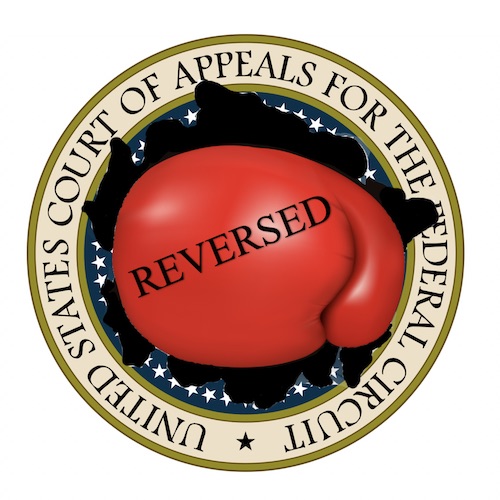“[O]n the point in dispute, all that is clear from K-fee’s submission to the EPO about a relevant artisan’s understanding of ‘barcode’ is that barcode messages use bars of varying widths—a matter of visual appearance.” – Judge Taranto
 On December 26, the U.S. Court of Appeals for the Federal Circuit (CAFC) issued a precedential decision in K-fee System GmbH v. Nespresso USA, Inc., reversing a claim construction ruling and summary judgment of noninfringement issued by the Central District of California. In construing the claim term “barcode” de novo, the Federal Circuit found that the district court erred in finding that its definition expressly excluded “bit codes” in light of the patent owner’s representations during European patent opposition proceedings.
On December 26, the U.S. Court of Appeals for the Federal Circuit (CAFC) issued a precedential decision in K-fee System GmbH v. Nespresso USA, Inc., reversing a claim construction ruling and summary judgment of noninfringement issued by the Central District of California. In construing the claim term “barcode” de novo, the Federal Circuit found that the district court erred in finding that its definition expressly excluded “bit codes” in light of the patent owner’s representations during European patent opposition proceedings.
Summary judgment was granted by U.S. District Judge George Wu after a ruling that construed the term “barcode,” which appears in each claim of three patents asserted by K-fee against coffee machines sold by Nespresso. The asserted patents claim methods of making a coffee beverage with the use of a capsule displaying a barcode that provides information on brewing parameters, including water temperature and quantity. Both parties argued the plain and ordinary meaning of “barcode” in district court before Judge Wu, who agreed with Nespresso that its definition could not include “bit code” of two binary symbols as used by Nespresso’s accused products.
District Court Was Too Confined by Statements Distinguishing Prior Art at EPO
Judge Wu’s claim construction relied upon intrinsic evidence from patent prosecution, including statements by K-fee’s patent attorney made during opposition proceedings at the European Patent Office (EPO) brought by an affiliate of Nespresso. In distinguishing an international patent application asserted by Nestec S.A. as prior art during the EPO proceedings, K-fee argued that the bit code disclosed by the prior art did not meet the claimed barcode limitation, which required bars having variable widths and more than two symbols. These opposition proceedings were presented to the U.S. Patent and Trademark Office during prosecution of K-fee’s U.S. patent rights, leading Judge Wu to consider those statements part of the intrinsic record of patent prosecution.
On appeal, K-fee argued that the district court’s ruling, which did not expressly mention prosecution disclaimer, improperly found that K-fee’s statements during the EPO opposition proceedings met the standard for disclaiming otherwise patentable subject matter. While the Federal Circuit noted that appellate briefing by both parties used the term “barcode” in multiple senses, it found that the individual message use of “barcode,” in which information is conveyed by non-uniformity in a display, did not exclude bit code even of the type disclosed by Nestec’s prior art reference.
A closer examination of the background of K-fee’s statements during the EPO opposition proceedings revealed that “the district court’s conclusion was too confining,” according to the opinion authored by Circuit Judge Richard Taranto. At points throughout K-fee’s EPO filings, K-fee acknowledged that barcodes could be embodied in bit code. Indeed, K-fee’s expert testified to the EPO that “[b]arcodes can therefore principally be regarded as a version of binary codes.” While Judge Wu’s claim construction ruling referenced these statements, the district court erred in holding that bit code could not be barcode in light of them.
Prior Art Bit Code Was Never Within the Scope of K-fee’s Barcode Claims
“[O]n the point in dispute, all that is clear from K-fee’s submission to the EPO about a relevant artisan’s understanding of ‘barcode’ is that barcode messages use bars of varying widths—a matter of visual appearance,” Judge Taranto wrote. The Federal Circuit found that K-fee’s arguments about the barcode’s visual appearance were “consistent with K-fee’s bottom-line purpose (which it fulfilled) of persuading the EPO that [the prior art] did not involve a ‘barcode.’” The bit code of the asserted prior art did not clearly reveal the use of bars having varying widths, and the record evidence established to the Federal Circuit that a skilled artisan would identify a barcode by visual appearance rather than any particular encoding of a data message.
Ambiguity in K-fee’s statements to the EPO also led the Federal Circuit to nix Nespresso’s disclaimer argument. First noting that arguments raised in footnotes are usually forfeited, the Federal Circuit saw no attempt by K-fee to act as a lexicographer by clearly defining “barcode.” K-fee distinguished the prior art by showing that the prior art’s bit code was never within K-fee’s claim scope, rather than K-fee disclaiming any of its own claim scope. Reversing Judge Wu’s claim construction order necessitated the reversal of summary judgment of noninfringement for Nespresso, leading the Federal Circuit to remand the case for a proper analysis of the accused products.
In briefly addressing the other sense of “barcode” used by K-fee and Nespresso on appeal, which more generally refers to systems of coding messages, the Federal Circuit simply noted that no argument had been made that a barcode system must never produce an individual message having bars of equal width.
Image Source: Deposit Photos
Image ID: 10042948
Author: almoond

![[IPWatchdog Logo]](https://ipwatchdog.com/wp-content/themes/IPWatchdog%20-%202023/assets/images/temp/logo-small@2x.png)

![[Advertisement]](https://ipwatchdog.com/wp-content/uploads/2024/04/UnitedLex-May-2-2024-sidebar-700x500-1.jpg)
![[Advertisement]](https://ipwatchdog.com/wp-content/uploads/2024/04/Patent-Litigation-Masters-2024-sidebar-700x500-1.jpg)

![[Advertisement]](https://ipwatchdog.com/wp-content/uploads/2021/12/WEBINAR-336-x-280-px.png)
![[Advertisement]](https://ipwatchdog.com/wp-content/uploads/2021/12/2021-Patent-Practice-on-Demand-recorded-Feb-2021-336-x-280.jpg)
![[Advertisement]](https://ipwatchdog.com/wp-content/uploads/2021/12/Ad-4-The-Invent-Patent-System™.png)






Join the Discussion
No comments yet.